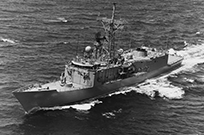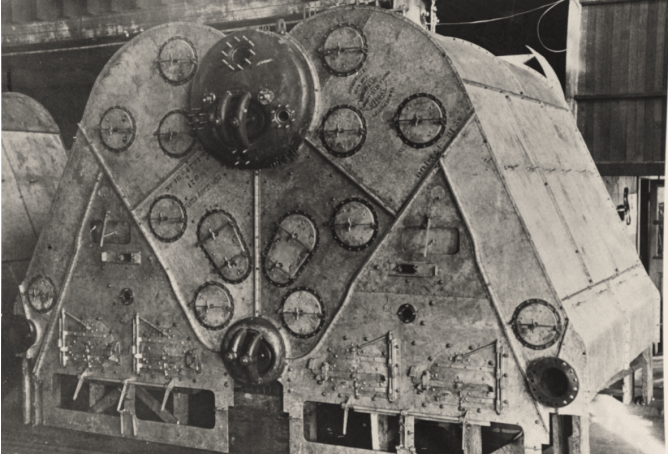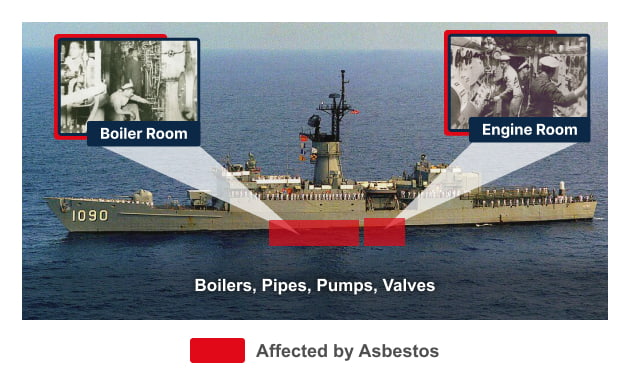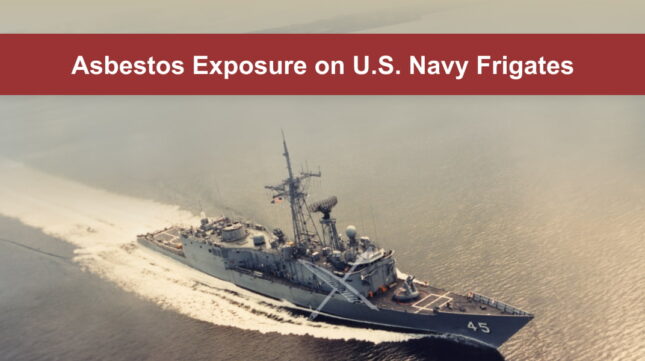From the 1930s to the early 1980s, almost all U.S. Navy frigates were made with a cancer-causing substance called asbestos. Now, Navy veterans who served on these frigates are at risk of asbestos-related diseases like mesothelioma as a result. We can help eligible veterans harmed by asbestos on frigates access military benefits, treatments, and legal compensation.
Was Asbestos Used on U.S. Navy Frigates?

Yes, the United States Navy relied on asbestos to build frigates and other naval vessels for decades.
Navy frigates were used during World War II and beyond to escort destroyers and help with patrols, and asbestos helped keep these vessels well-insulated and fireproof.
Anyone exposed to asbestos on frigates could develop mesothelioma and other serious illnesses. It takes 10-50 years for mesothelioma to develop after asbestos exposure, so Navy veterans who served decades ago are still at risk today.
Video Summary: U.S. Navy frigates relied on asbestos for decades, and veterans who served on are them at risk of mesothelioma. Get help if you or a loved one got sick from exposure to asbestos on frigates. View Transcript
From the 1930s until the early 1980s, the vast majority of frigates in the U.S. Navy were made with products that contained asbestos, such as insulation and piping. As a result, many U.S. Navy veterans who served on frigates during this time may now be at risk of asbestos-related illnesses like mesothelioma.
The health risks associated with asbestos exposure are well-documented. However, there is hope for veterans who got sick from serving on frigates.
The U.S. Department of Veterans Affairs (VA) offers benefits for veterans who have been diagnosed with asbestos-related illnesses. These benefits include monthly compensation, free or low-cost medical care, and financial support for loved ones.
In addition, there are also private sources of financial aid available to veterans seeking compensation for mesothelioma. A private legal claim, for example, can award a significant payout.
If you served aboard a U.S. Navy frigate and now have mesothelioma, reach out to our team. The Mesothelioma Veterans Center can get you the help you deserve.
The Mesothelioma Veterans Center can help veterans with mesothelioma get benefits from the U.S. Department of Veterans Affairs (VA) if eligible. We can also help qualifying veterans file lawsuits to potentially secure additional compensation.
Learn about all the ways we can assist you with our Free Veterans Packet.
List of U.S. Navy Frigates With Asbestos
Over 100 U.S. Navy frigates contained asbestos. See if a ship you served on used asbestos-based products below.
U.S. Navy frigates that used asbestos include:
- USS Ainsworth (FFT-1090)
- USS Albert David (FF-1050)
- USS Antrim (FFG-20)
- USS Aubrey Fitch (FFG-34)
- USS Aylwin (FF-1081)
- USS Badger (FF-1071)
- USS Bagley (FF-1069)
- USS Barbey (FF-1088)
- USS Blakely (FF-1072)
- USS Boone (FFG-28)
- USS Bowen (FFT-1079)
- USS Bradley (FF-1041)
- USS Brewton (FF-1086)
- USS Bronstein (FF-1037)
- USS Brooke (FFG-1)
- USS Brumby (FF-1044)
- USS Capodanno (FF-1093)
- USS Clark (FFG-11)
- USS Clifton Sprague (FFG-16)
- USS Connole (FF-1056)
- USS Cook (FF-1083)
- USS Copeland (FFG-25)
- USS Crommelin (FFG-37)
- USS Curts (FFG-38)
- USS Davidson (FF-1045)
- USS De Wert (FFG 45)
- USS Donald B. Beary (FFT-1085)
- USS Downes (FF-1070)
- USS Doyle (FFG-39)
- USS Duncan (FFG-10)
- USS Edward McDonnell (FF-1043)
- USS Elmer Montgomery (FF-1082)
- USS Estocin (FFG-15)
- USS Fahrion (FFG-22)
- USS Fanning (FF-1076)
- USS Flatley (FFG-21)
- USS Francis Hammond (FF-1067)
- USS Gallery (FFG-26)
- USS Garcia (FF-1040)
- USS Gary (FFG-51)
- USS George Philip (FFG-12)
- USS Glover (AGFF-1)
- USS Gray (FF-1054)
- USS Halyburton (FFG-40)
- USS Harold E. Holt (FF-1074)
- USS Hepburn (FF-1055)
- USS Ingraham (FFG-61)
- USS Jack Williams (FFG-24)
- USS Jarrett (FFG-33)
- USS Jesse L. Brown (FFT-1089)
- USS John A. Moore (FFG-19)
- USS John L. Hall (FFG-32)
- USS Joseph Hewes (FFT-1078)
- USS Julius A. Furer (FFG-6)
- USS Kauffman (FFG-59)
- USS Kirk (FF-1087)
- USS Klakring (FFG-42)
- USS Knox (FF-1052)
- USS Koelsch (FF-1049)
- USS Lang (FF-1060)
- USS Lewis B. Puller (FFG-23)
- USS Lockwood (FF-1064)
- USS Mahlon S. Tisdale (FFG-27)
- USS Marvin Shields (FF-1066)
- USS McCandless (FFT-1084)
- USS McCloy (FF-1038)
- USS McClusky (FFG-41)
- USS McInerney (FFG-8)
- USS Meyerkord (FF-1058)
- USS Miller (FF-1091)
- USS Moinester (FFT-1097)
- USS Nicholas (FFG-47)
- USS O’Callahan (FF-1051)
- USS Oliver Hazard Perry (FFG-7)
- USS Ouellet (FF-1077)
- USS Patterson (FF-1061)
- USS Paul (FF-1080)
- USS Pharris (FF-1094)
- USS Ramsey (FFG-2)
- USS Rathburne (FF-1057)
- USS Reasoner (FF-1063)
- USS Reid (FFG-30)
- USS Rentz (FFG-46)
- USS Richard L. Page (FFG-5)
- USS Roark (FF-1053)
- USS Robert E. Peary (FF-1073)
- USS Robert G. Bradley (FFG-49)
- USS Sample (FF-1048)
- USS Samuel Eliot Morison (FFG-13)
- USS Schofield (FFG-3)
- USS Sides (FFG-14)
- USS Stark (FFG 31)
- USS Stein (FF-1065)
- USS Stephen W. Groves (FFG-29)
- USS Talbot (FFG-4)
- USS Taylor (FFG-50)
- USS Thach (FFG-43)
- USS Thomas C. Hart (FF-1092)
- USS Trippe (FF-1075)
- USS Truett (FFT-1095)
- USS Underwood (FFG-36)
- USS Valdez (FF-1096)
- USS Vandegrift (FFG-48)
- USS Voge (FF-1047)
- USS Vreeland (FF-1068)
- USS W. S. Sims (FF-1059)
- USS Wadsworth (FFG-9)
- USS Whipple (FF-1062)
You might have been exposed to asbestos even if you don’t see your ship listed above. Nearly all U.S. Navy ships made before the early 1980s used asbestos-based products.
Products Made With Asbestos on Frigates
The U.S. Navy used over 300 products containing asbestos on frigates and other ships before the dangers of this mineral became public knowledge.
Learn about the products that posed the highest risk to U.S. Navy veterans serving on frigates below.
Boilers


Boilers helped power the engine and supply steam throughout the ship. They often relied on asbestos products like gaskets to control heat.
Boiler rooms were often small areas with poor ventilation. Boilermakers may have inhaled asbestos dust that was kicked up while repairing or maintaining boilers.
“I was a boiler tender when I went aboard my first ship and started doing my first job. I asked them what the material was made out of and they told me it was asbestos. It didn’t kill anybody on the spot. It took years later. That’s when it started catching up with us.”
Pipes
Ship pipes were wrapped in asbestos insulation to regulate temperature and help them work efficiently.
Pipefitters often made new insulation by mixing dry asbestos dust with water and adding it around the pipe, which could easily send fibers into the air.
Pumps
Many pumps on frigates and other ships were insulated and packed with asbestos to prevent heat from escaping. As Navy machinist mates renovated the pipes, they may have been exposed.
Valves
Many valves used asbestos to withstand high pressures and temperatures. Navy service members who had to replace damaged valves risked asbestos exposure.
These are just a few of many asbestos-based products that Navy personnel may have been exposed to while serving on frigates.

Who Was at Risk of Asbestos on Frigates?
Any U.S. Navy veterans who served on a frigate built with asbestos-based products could have been exposed. That said, veterans who had the highest risk worked with or around asbestos every day.
Those at a very high risk of asbestos on frigates included:
- Boiler room workers
- Engine room workers
- Machinists mates
- Navigation room workers
- Pipefitters and plumbers
Veterans who worked in U.S. Navy shipyards were also at risk of exposure from handling products made with asbestos on frigates and other vessels.
This is because shipyard workers had to directly repair, replace, and install asbestos-containing products every day.
Compensation for Navy Veterans With Mesothelioma
If you or a loved one developed mesothelioma after being exposed to asbestos on frigates or other Navy vessels, you may qualify for financial compensation.
Eligible Navy veterans can pursue compensation from:
- VA benefits: VA mesothelioma disability compensation awards over $4,000 a month and you can also get free or low-cost medical treatments with VA health care. We can help you file for or increase your VA benefits.
- Mesothelioma lawsuits: Our team can file a lawsuit against private companies that made the asbestos materials that made you sick. These lawsuits are not filed against the military or government and award $1 million or more on average.
- Asbestos trust fund claims: Bankrupt asbestos companies were forced to put money into trusts to avoid lawsuits and reimburse those who were harmed. More than $30 billion in total is available in these trusts, and we can help you access your share of this money.
Our partner lawyers recently secured $2 million for a veteran from North Carolina. He worked as a boiler room technician on the frigate USS Stein, the destroyer USS Bryce Canyon, and at a U.S. Navy training center.
The Mesothelioma Veterans Center will proudly help you retrieve mesothelioma compensation if eligible. Learn more about your options in our Free Veterans Packet.
Help for Navy Veterans Exposed to Asbestos on Frigates
Each year, far too many brave U.S. Navy veterans develop mesothelioma that can be traced back to asbestos on frigates and other naval ships.
A mesothelioma diagnosis can bring a lot of stress, but the Mesothelioma Veterans Center is here to support you and your family in any way we can.
We have nurses, patient advocates, and VA-accredited lawyers on staff who are ready to help.
By working with our team, you may be able to:
- File a VA claim or increase your existing benefits
- Find top mesothelioma doctors and hospitals that treat veterans
- Get compensation through legal claims
- Protect your family’s future
Learn about the benefits that may be available to you or a loved one: Get a Free Veterans Packet or call (877) 450-8973 now to get started.
Asbestos on Frigates FAQs
Which Navy ships had asbestos?
Hundreds of frigates and other Navy ships used asbestos before the risks were known.
Just a few frigates that contained this substance were:
- USS Cook (FF-1083)
- USS Davidson (FF-1045)
- USS Hepburn (FF-1055)
- USS McCandless (FFT-1084)
Anyone exposed to asbestos on these ships could develop mesothelioma later in life.
Do Navy ships still have asbestos?
The military no longer uses asbestos in new ships.
All U.S. Navy frigates that contained asbestos have been decommissioned. As of 2025, there are no frigates in the Navy’s fleet.
Only a very small handful of older ships still in service use asbestos, and they are monitored to keep sailors safe.
What was asbestos used for in the Navy?
Asbestos products were used to make U.S. Navy frigates and other vessels resistant to fire, heat, and corrosion. It also kept the ships well-insulated.
U.S. Navy personnel didn’t know that asbestos on frigates could lead to mesothelioma until the early 1980s — 50 years after it was first used by the military.
This is because companies that made and sold asbestos-containing materials hid the health risks to make a profit.
When was asbestos banned on frigates?
The use of asbestos on frigates and other naval vessels was banned in the late 1970s. Steps were taken to remove asbestos products from ships and other military assets.
U.S. Navy veterans may have been at risk of asbestos exposure up through the 1980s though, as removal efforts took time and cost millions of dollars.
Are there benefits for Navy veterans harmed by asbestos on frigates?
Yes. U.S. Navy veterans who developed mesothelioma from asbestos on frigates can file VA benefits claims to get monthly compensation, low-cost health care, and access to other helpful resources.
Veterans typically receive over $4,000 a month in 2025 through VA benefits. They can also get treatment from top mesothelioma doctors who have partnered with the VA.
We can help veterans file for or increase their VA benefits. Call (877) 450-8973 to learn more.
How serious is one-time asbestos exposure?
Even one exposure to asbestos can cause mesothelioma.
If you believe you were exposed to asbestos on frigates and now have mesothelioma, you may qualify for VA benefits.


